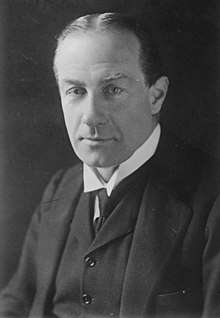1929 United Kingdom general election
The 1929 United Kingdom general election was held on Thursday 30 May and resulted in a hung parliament. It stands as the fourth of six instances under the secret ballot, and the first of three under universal suffrage, in which a party has lost on the popular vote but won the highest number (known as "a plurality") of seats versus all other parties – others are 1874, January 1910, December 1910, 1951 and February 1974. In 1929, Ramsay MacDonald's Labour Party won the most seats in the House of Commons for the first time. The Liberal Party re-led by ex-Prime Minister David Lloyd George regained some ground lost in the 1924 election and held the balance of power.
| |||||||||||||||||||||||||||||||||||||||||||||
All 615 seats in the House of Commons 308 seats needed for a majority | |||||||||||||||||||||||||||||||||||||||||||||
|---|---|---|---|---|---|---|---|---|---|---|---|---|---|---|---|---|---|---|---|---|---|---|---|---|---|---|---|---|---|---|---|---|---|---|---|---|---|---|---|---|---|---|---|---|---|
| Turnout | 76.3%, | ||||||||||||||||||||||||||||||||||||||||||||
| |||||||||||||||||||||||||||||||||||||||||||||
 Colours denote the winning party—as shown in § Results | |||||||||||||||||||||||||||||||||||||||||||||
| |||||||||||||||||||||||||||||||||||||||||||||
The election was often referred to as the "Flapper Election", because it was the first in which women aged 21–29 had the right to vote (due to the Representation of the People Act 1928). (Women over 30 had been able to vote since the 1918 election.)
The election was fought against a background of rising unemployment, with the memory of the 1926 general strike still fresh in voters' minds. By 1929, the Cabinet was being described by many as "old and exhausted".[1]
The Liberals campaigned on a comprehensive programme of public works under the title "We Can Conquer Unemployment". The incumbent Conservatives campaigned on the theme of "Safety First", with Labour campaigning on the theme of "Labour & the Nation".
This was the first general election to be contested by the newly formed Welsh nationalist party Plaid Cymru.
It stood as the last time when a "third party" non-Labour or Conservative polled more than one-fifth of the popular vote until 1983, the next election thus ushering in five decades in which two-party politics dominated.
Results
| 287 | 260 | 59 | 9 |
| Labour | Conservative | Lib | O |
| Candidates | Votes | ||||||||||
|---|---|---|---|---|---|---|---|---|---|---|---|
| Party | Leader | Stood | Elected | Gained | Unseated | Net | % of total | % | No. | Net % | |
| Conservative | Stanley Baldwin | 590 | 260 | 2 | 154 | −152 | 42.3 | 38.1 | 8,252,527 | −8.7 | |
| Labour | Ramsay MacDonald | 569 | 287 | 140 | 4 | +136 | 46.7 | 37.1 | 8,048,968 | +3.8 | |
| Liberal | David Lloyd George | 513 | 59 | 36 | 17 | +19 | 9.6 | 23.6 | 5,104,638 | +5.8 | |
| Independent | N/A | 11 | 4 | 3 | 1 | +2 | 0.8 | 0.4 | 94,742 | +0.2 | |
| Communist | Harry Pollitt | 25 | 0 | 0 | 1 | −1 | 0.2 | 47,554 | −0.1 | ||
| Ind. Conservative | N/A | 8 | 0 | 0 | 0 | 0 | 0.2 | 46,278 | |||
| Scottish Prohibition | Edwin Scrymgeour | 1 | 1 | 0 | 0 | 0 | 0.2 | 0.1 | 25,037 | +0.1 | |
| Nationalist | Joseph Devlin | 3 | 2 | 2 | 0 | +2 | 0.5 | 0.1 | 24,177 | +0.1 | |
| Independent Labour | N/A | 4 | 1 | 1 | 0 | +1 | 0.2 | 0.1 | 20,825 | +0.1 | |
| Independent Liberal | N/A | 2 | 0 | 0 | 0 | 0 | 0.1 | 17,110 | +0.1 | ||
| National (Scotland) | Roland Muirhead | 2 | 0 | 0 | 0 | 0 | 0.0 | 3,313 | N/A | ||
| Plaid Cymru | Saunders Lewis | 1 | 0 | 0 | 0 | 0 | 0.0 | 609 | N/A | ||
| Irish Nationalist | T. P. O'Connor | 1 | 1 | 0 | 0 | 0 | 0.0 | 0 | N/A | ||
Votes summary
Seats summary
Constituency results
Transfers of seats
- All comparisons are with the 1924 election.
- In some cases, the change is owing to the MP having defected to the gaining party, and then retaining the seat in 1929. Such circumstances are marked with a *.
- In other circumstances, the change is owing to the seat having been won by the gaining party in a by-election in the intervening years, and then retained in 1929. Such circumstances are marked with a †.
- 1 Previous MP had defected to the Conservatives by the 1929 election
- 2 Previous MP had defected to the Liberals by the 1929 election
See also
References
- Doerr, pp. 104–5.
- Tetteh, Edmund (1 February 2008). "Election Statistics: UK 1918-2007" (PDF). parliament.uk. Archived from the original (PDF) on 8 July 2014. Retrieved 23 May 2014.
Sources
- Craig, F. W. S. (1989), British Electoral Facts: 1832–1987, Dartmouth: Gower, ISBN 0900178302
- Doerr, Paul W. (1998), British foreign policy 1919–1939, Manchester: Manchester University Press, ISBN 0719046718
Further reading
- Howell, David (2002), MacDonald's Party: Labour Identities and Crisis, 1922–1939, Oxford
- Redvaldsen, David (2010), "'Today is the Dawn': The Labour Party and the 1929 General Election", Parliamentary History, 29 (3): 395–415, doi:10.1111/j.1750-0206.2010.00213.x
- Williamson, Philip (1982), "'Safety First': Baldwin, the Conservative Party and the 1929 General Election" (PDF), Historical Journal, 25 (2): 385–409, doi:10.1017/S0018246X00011614
.jpg)

